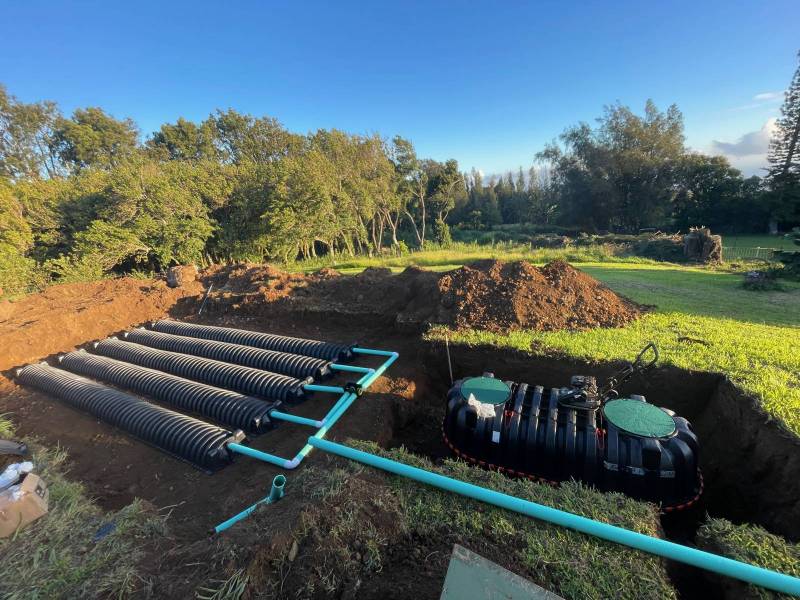Cesspool to Septic Conversion in Hawaiʻi – A First Hand Experience
Letʻs take it from the top. Hawai’i has nearly 88,000 cesspools that some sources say put 53 million gallons per day of raw sewage into the State’s groundwater and surface waters. A cesspool is basically a big hole in the ground with a cement cover – a wastewater solution that was common in rural areas without government or private sewer systems. Over half of residential properties here on the Big Island have a permitted cesspool. For many locations, it still works really well and without any danger of contaminating water resources.
That having been said, in areas close to the ocean in particular, cesspools are damaging to the environment. In some locations they can indeed be contaminating potable water supplies. If you have a property (or are considering buying one) that currently has a cesspool, just continuing to use it is no longer an option. A State law passed in 2017 requires that all cesspools be converted to septic systems or the homes connected to a sewer line, by 2050.
There are challenges to doing this. Here on Hawaiʻi Island only the urbanized areas like Kona and Hilo have public sewer systems. Private systems serve resort areas. The cost is of conversion is prohibitive for many homeowners, even with the small tax credits offered so far. And many homeowners literally do not have room on their property to construct a septic system with its drainage field.
The process of converting your cesspool to a septic system is not a DIY job. Because it is a matter of health and safety, the State requires that an engineer apply for the wastewater permit, and a licensed contract do the installation.
When I prepared to apply for the building permit for my small renovation project, my architect advised me that because I was adding a bathroom, the County building permit would require that I obtain a State Department of Health Wastewater Branch permit and convert my cesspool to septic at that time. So even before my building permit was processed, I began to plan for the conversion. Here is my experience.

Septic system installation underway in my back yard – septic tank on the right, drainage field under construction on the left
Getting a Permit for Your Cesspool to Septic Conversion in Hawaiʻi
Much as I began the building permit process for my renovation by contacting an architect and having him translate my idea and wish list into an architectural plan meeting all the County Building specifications, the first step was hiring a professional engineer to create the necessary documents for review by the Hawaiʻi Department of Health Wastewater Branch. In the statute that regulates them, cesspool and septic systems are called “individual wastewater systems” or “IWS” for short, and for the initial construction or a conversion, a Individual Wastewater System application must be filed by a State of Hawaiʻi licensed engineer.
Just like the plans for my building permit application showed a site plan and the specifications for the construction including electrical and plumbing, the IWS application required a site plan and specifications for the septic system to be installed. The engineer submitted my application on February 15, 2022, and we received an approval letter March 22, 2022.
Next Step: Getting the Septic System Installed
As I mentioned above, you cannot install an IWS yourself unless you happen to be a Hawaii State licensed contractor holding an A, C-9, C-37, C-37a or C-43 license. The work must be supervised by the engineer who did the plans and filed the application. Once the physical work is completed, the engineer will submit an as-built report to the Department of Health. They will then issue an authorization to use the IWS. You may not use the new system prior to receiving that authorization.
The contractor working on my installation is also in regular communication with the licensed plumber working on my renovation project so that when the system is physically complete and authorized for use, he can “flip the switch” so to speak.
How Much Will It Cost?
Much as with other construction costs over the past few years, prices for the components of septic systems have increased considerably due to demand. Between engineering, the septic system itself, installation of the septic and decommissioning of the cesspool, the total cost will be around $20,000. Thatʻs right in line with the estimates Iʻve seen in recent articles about various plans and bills moving through the state legislature to provide financial assistance to homeowners for whom those costs are simply not feasible.




Bruddah Al
November 21, 2024
Not sure that estimated installation cost reflects reality. We just got quotes for a septic install in Honolulu ranging from 464k on the high side to 120k on the low side. Our neighbor had his installed this year and his was around 100k
Beth Thoma Robinson
November 21, 2024
> Thatʻs crazy! Perhaps some of our Oʻahu-based agents will have a better feel for what this costs in urban areas. But I can assure you that this was the actual cost of installing mine in Hawi, North Kohala and pretty representative of other experiences here.